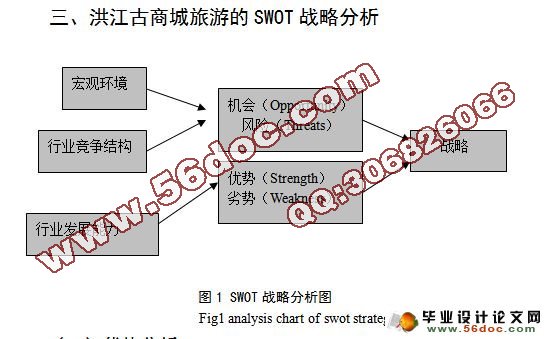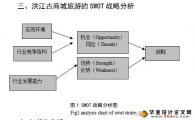洪江古商城旅游发展战略探究
来源:56doc.com 资料编号:5D10541 资料等级:★★★★★ %E8%B5%84%E6%96%99%E7%BC%96%E5%8F%B7%EF%BC%9A5D10541
资料以网页介绍的为准,下载后不会有水印.资料仅供学习参考之用. 密 保 惠 帮助
资料介绍
洪江古商城旅游发展战略探究(18000字)
摘 要:洪江古商城是我国江南民居古建筑之精典,具有极高的旅游开发价值。作为重要的旅游资源,古商城以其悠久的历史、独特的居民建筑、深厚的文化底蕴、优美的山水风貌吸引着众多游客前往,当地的旅游业得到迅速发展,古商城旅游的发展也正成为其中的热点。古商城旅游业的发展提升了当地的经济水平,但在发展的过程中存在的问题也比较普遍,本文以通过对其现状进行研究,分析其中的优势与劣势,针对古商城旅游的特点及其发展的制约因素提出合理的具有建设性的建议和战略选择。
关键词:洪江古商城;swot分析;战略选择
Hongjiang ancient commercial city tourism development strategy
Abstract:Hongjiang Ancient Commercial city of China's southern residential areas of the classics of ancient buildings, has a very high value tourism development.As an important tourism resource, ancient commercial city with its long history, unique residential buildings, rich cultural heritage, beautiful scenery attracts many visitors to the style of the local tourism industry developed rapidly, the development of Hongjiang Ancient City tourism is becoming one of the hot spots.Hongjiang Ancient City tourism levels to enhance the local economy, but in the process of development problems are also relatively common, this situation through its research, analysis of the strengths and weaknesses, for the characteristics of its ancient commercial tourism in the development of a reasonable and constructive proposals and strategic choice.
Key words:Hongiiang Ancient Commercia1 City;Swot Analysis;Strategic choice

目 录
摘要 …………………………………………………………………………………………1
关键词 ………………………………………………………………………………………1
一、绪论 ……………………………………………………………………………………1
(一)选题的目的与意义 ……………………………………………………………1
(二)国外对旅游战略管理的研究 …………………………………………………2
(三)国内对旅游战略管理的研究 …………………………………………………3
二、洪江古商城旅游业现状 ………………………………………………………………5
(一)资源概况 ………………………………………………………………………5
(二)商文化特色 ……………………………………………………………………6
(三)发展动向 ………………………………………………………………………6
(四)主要经济指标 …………………………………………………………………7
三、洪江古商城旅游的SWOT分析…………………………………………………………8
(一)优势分析 ………………………………………………………………………8
1、旅游资源丰富…………………………………………………………………8
2、历史和商业文化悠久…………………………………………………………8
3、区位条件优越…………………………………………………………………9
4、政府支持………………………………………………………………………9
(二)劣势分析 ………………………………………………………………………9
1、区划调整带来不利影响………………………………………………………9
2、旅游基础服务设施不完善 …………………………………………………10
3、国内旅游市场培育不足 ……………………………………………………10
4、当地经济发展缓慢 …………………………………………………………10
5、旅游产品类型单一 …………………………………………………………10
6、管理机制不完善 ……………………………………………………………10
(三)机会分析………………………………………………………………………11
1、旅游业的蓬勃发展 …………………………………………………………11
2、旅游需求日益多样性 ………………………………………………………11
3、西部大开发带来经济发展机遇 ……………………………………………11
4、产业结构调整的契机 ………………………………………………………11
5、旅游设施逐步完善 …………………………………………………………11
(四)威胁分析………………………………………………………………………12
1、旅游业竞争加剧 ……………………………………………………………12
2、需投入更多成本 ……………………………………………………………12
3、旅游业发展的日益差异化 …………………………………………………12
四、洪江古商城旅游战略的选择…………………………………………………………13
(一) 发展型战略 …………………………………………………………………13
1、树立特色品牌 ………………………………………………………………13
2、注重宣传策略 ………………………………………………………………13
3、注重开发旅游产品 …………………………………………………………14
(二)扭转型战略………………………………………………………………………14
1、优化交通路线 ………………………………………………………………14
2、重视综合效益 ………………………………………………………………14
3、树立经营理念 ………………………………………………………………15
(三)防御型战略……………………………………………………………………15
1、注重区域合作 ………………………………………………………………15
2、突出核心竞争优势 …………………………………………………………15
(四)组合型战略……………………………………………………………………15
1、注重资源整合开发 …………………………………………………………15
2、旅游相关产业的组合 ………………………………………………………16
3、文化整合传播 ………………………………………………………………16
五、结束语…………………………………………………………………………………17
参考文献……………………………………………………………………………………17
致谢…………………………………………………………………………………………19
|



